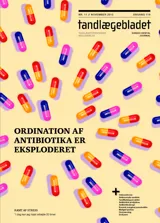Lokal destruktion af parodontale væv i relation til en oral
Denne kasuistik demonstrerer, at orale piercinger kan være associeret med omfattende lokaliseret parodontal destruktion. Tandlægen bør derfor informere patienter med orale piercinger om, at udsmykning med disse kan medføre en øget risiko for udvikling af oral sygdom.
Baggrund – Marginal parodontitis er en multifaktoriel sygdom, som udvikles som følge af akkumulation af bakterielt deriveret plak langs margo gingiva, hvilket resulterer i en lokal inflammatorisk reaktion i tændernes støttevæv. Tilstedeværelsen af fremmedlegemer, herunder orale piercinger, kan aggravere lokal parodontal sygdomsprogression gennem iatrogen skade af gingiva og kan dermed lokalt resultere i et mere alvorligt sygdomsforløb med øget risiko for tandtab.
Patienttilfælde – Denne kasuistik beskriver omfattende lokal parodontal destruktion i relation til en labial piercing, der havde været anvendt i ca. 20 år hos en systemisk rask, ikke-rygende mand uden erkendt marginal parodontitis. Ved den kliniske og radiologiske undersøgelse identificeredes omfattende destruktion af marginal knogle ved underkæbens incisiver, som havde været i tæt kontakt med den labiale piercing. Den lokale parodontale destruktion stod i skarp kontrast til patientens generelle parodontale tilstand.
Konklusion – Denne kasuistik demonstrerer, at orale piercinger kan være associeret med omfattende lokaliseret parodontal destruktion. Tandlægen bør derfor informere patienter med orale piercinger om, at udsmykning med disse kan medføre en øget risiko for udvikling af oral sygdom.
Background - Periodontitis is a multifactorial disease that is caused by accumulation of bacterial derived plaque, which initiates a local inflammatory reaction in the tooth supporting tissue. Foreign objects, including oral piercings, may aggravate local periodontal disease activity through iatrogenic damage of gingiva, and may therefore result in a more pronounced disease progression with an increased risk of tooth loss.
Case study – This case-report presents severe localized periodontitis in relation to a labial piercing worn for more than 20 years, by a systemically healthy, non-smoking male with no previous history of periodontitis. The clinical and radiological examination showed severe localized destruction of marginal bone in the frontal region of the mandible, which had been in close proximity to the labial piercing. Major difference was observed between the local periodontal lesion and the general periodontal status of this patient.
Conclusion – This case demonstrates that oral piercings may be associated with severe localized periodontal disease activity. Thus, the dentist should inform any subject with oral piercings that these may result in increased risk of developing oral diseases.


